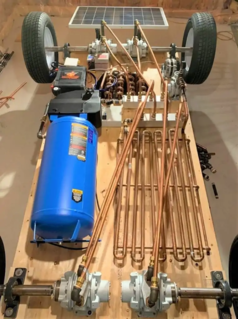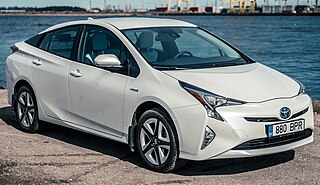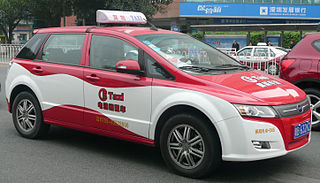
A compressed-air car is a compressed-air vehicle fuelled by pressure vessels filled with compressed air and propelled by the release and expansion of the air within a Pneumatic motor or motor adapted to compressed air. The car can be powered solely by air, or combined with gasoline, diesel, ethanol, or an electric plant with regenerative braking. Compressed-air cars operate according to a thermodynamic process where air cools down when expanding and heats up when being compressed and those are thermal energy losses that drain the capacity factor of compressed air, however with the recent developments in isothermal compressed air energy storage ICAES plants, compressed air storage has reached 4 times the capacity factor of lithium-ion batteries with 2.7Mj/kg or 3.6Mj/m3 and in 2020 there has been developments in ICAV car or isothermal compressed air vehicle published by Dr. Reza Alizade Evrin from Ontario Tech University with a first prototype that uses low pressure air tanks and exhaust air recovery to power a paraffin heat exchanger system with a global energy efficiency of 74% with a driving range of 140 km. This efficiency and range can be increased by using storage tank as car chassis structure, high pressure tanks, new rotary engines, and a more efficient heat exchanger, this breakthrough together with the availability of recycled and bio-based thermoplastics for tanks and pneumatic components and renewable energy means this technology can be the basis of a free green transportation revolution with energy and circular industry decentralization with open source numerical control machines fabrication including additive manufacturing while multistage air compressors and coolers or hydraulic pumps can be attached directly to VAWT wind turbines, stirling engine with a parabolic or fresnel lens solar concentrator or river, tidal, wave hydropower turbine with no electric energy or electric grid needed nor energy conversion inefficiencies or additional energy storage, also instead of onboard heat recovery system there can be used a refillable molten salt reservoir in a heat exchanger system.

The Toyota Prius is a car built by Toyota which has a hybrid drivetrain, combining an internal combustion engine with an electric motor. Initially offered as a four-door sedan, it has been produced only as a five-door liftback since 2003.

A compressed-air vehicle (CAV) is a transport mechanism fueled by tanks of pressurized atmospheric gas and propelled by the release and expansion of the gas within a Pneumatic motor.

A solar vehicle or solar electric vehicle is an electric vehicle powered completely or significantly by direct solar energy. Usually, photovoltaic (PV) cells contained in solar panels convert the sun's energy directly into electric energy. The term "solar vehicle" usually implies that solar energy is used to power all or part of a vehicle's propulsion. Solar power may be also used to provide power for communications or controls or other auxiliary functions.
Hybrid vehicle drivetrains transmit power to the driving wheels for hybrid vehicles. A hybrid vehicle has multiple forms of motive power.

Durham University Electric Motorsport (DUEM) is a student-run team in the United Kingdom that designs and constructs solar powered cars to compete in international competitions. DUEM is the longest running solar car team in the UK and is financed entirely by third party donations and sponsorship.
MIEV or MiEV is the name given by Japanese automaker Mitsubishi Motors (MMC) to its alternative propulsion technologies. From late 2006, “MiEV” encompasses all of Mitsubishi Motors’s electric drive systems work, including lithium-ion batteries, in-wheel motors and other technologies related to electric vehicle(EV), hybrid-electric vehicle and fuel-cell vehicles.

An alternative fuel vehicle is a motor vehicle that runs on alternative fuel rather than traditional petroleum fuels. The term also refers to any technology powering an engine that does not solely involve petroleum. Because of a combination of factors, such as environmental concerns, high oil-prices and the potential for peak oil, development of cleaner alternative fuels and advanced power systems for vehicles has become a high priority for many governments and vehicle manufacturers around the world.
The Sunraycer was a solar-powered race car designed to compete in the World Solar Challenge, the world's first race featuring solar-powered cars. The Sunraycer was a joint collaboration between General Motors, AeroVironment, and Hughes Aircraft.

Andrew Alfonso Frank is an emeritus American professor of Mechanical and Aeronautical Engineering at University of California, Davis. He is recognized as the father of modern plug-in hybrids, and coined the now-common term Plug-in Hybrid Electric Vehicle (PHEV). He has a B.S.M.E degree (1955) from the University of California, Berkeley, a M.S.M.E (1958), from the University of California, Berkeley, a M.S.E.E (1965) from the University of Southern California, and holds a Ph.D. in E.E (1968) from the University of Southern California. Frank worked at North American Aviation then North American/Rockwell Aviation from 1955 to 1968 on programs such as the X15 Research Aircraft, Helicopter stability and control systems, the Apollo Project to the moon, and the Minuteman intercontinental ballistic missile programs. He received patents and provided many innovations and solutions that allowed the programs to be more successful and effective. His patents continue to be in use today.
The canal boat Ross Barlow is a hybrid hydrogen narrowboat, power-assisted by an electric motor whose electricity is supplied by a fuel cell or a battery. It debuted on 21 September 2007.

An electric vehicle battery is a rechargeable battery used to power the electric motors of a battery electric vehicle (BEV) or hybrid electric vehicle (HEV). Typically lithium-ion batteries, they are specifically designed for high electric charge capacity.

A battery electric vehicle (BEV), pure electric vehicle, only-electric vehicle, fully electric vehicle or all-electric vehicle is a type of electric vehicle (EV) that exclusively uses chemical energy stored in rechargeable battery packs, with no secondary source of propulsion. BEVs use electric motors and motor controllers instead of internal combustion engines (ICEs) for propulsion. They derive all power from battery packs and thus have no internal combustion engine, fuel cell, or fuel tank. BEVs include – but are not limited to – motorcycles, bicycles, scooters, skateboards, railcars, watercraft, forklifts, buses, trucks, and cars.
This is a list of concept vehicles from Toyota for the years 2010–2019.

The Toyota Prius (XW10) is a subcompact hybrid car that was produced by Toyota between 1997 and 2003 in Japan. The XW10 is divided into the NHW10 and its NHW11 counterpart, both of which represent the first generation of Prius series. The Toyota Prius is the first mass-produced hybrid car, and was released 2 years ahead of other manufacturers. While the NHW10 was available exclusively to Japan, it was subsequently introduced to worldwide markets in September 2000 with the NHW11. Toyota sold about 123,000 first generation Prius. Toyota's XW10 series Prius is notable as the first vehicle based on the Toyota MC platform.

The Ford Focus Electric is a 5-door hatchback electric car produced by Ford. The Focus Electric is Ford's second production all-electric vehicle, and production began in December 2011.

The Electric vehicle industry in China is the largest in the world, accounting for around 57.4% of global production of EVs and around 500,000 exports in 2021. In 2021, CAAM reported China had sold 3.34 million passenger electric vehicles, consisting 2.73 million BEVs and 0.6 million PHEV, which is around 53% share of the global market of 6.23 million "new energy" passenger vehicles – BEVs, PHEVs, and HEVs. China also dominates the plug-in electric bus and light commercial vehicle market, reaching over 500,000 buses and 247,500 electric commercial vehicles in 2019, and recording new sales of 186,000 commercial EVs in 2021.
The University of Kansas Sustainable Automotive Energy Infrastructure Initiative, or more commonly referred to as the KU Ecohawks is an ongoing project that works to promote sustainability in the automotive sector. Founded during the beginning of the Automotive industry crisis of 2008–2010 in the U.S., the group recycles old vehicles to run on community wastes and renewables, especially on the University of Kansas campus and not rely on conventional fossil fuel sources that pollute the local and global environment.

Electric cars have a smaller environmental footprint than conventional internal combustion engine vehicles (ICEVs). While aspects of their production can induce similar, less or alternative environmental impacts, they produce little or no tailpipe emissions, and reduce dependence on petroleum, greenhouse gas emissions, and health effects from air pollution. Electric motors are significantly more efficient than internal combustion engines and thus, even accounting for typical power plant efficiencies and distribution losses, less energy is required to operate an EV. Manufacturing batteries for electric cars requires additional resources and energy, so they may have a larger environmental footprint from the production phase. EVs also generate different impacts in their operation and maintenance. EVs are typically heavier and could produce more tire, brake, and road dust air pollution, but their regenerative braking could reduce such particulate pollution from brakes. EVs are mechanically simpler, which reduces the use and disposal of engine oil.












